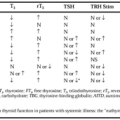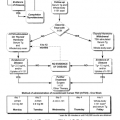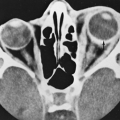SUBSTERNAL GOITER
Part of “CHAPTER 38 – NONTOXIC GOITER“
Substernal goiter refers to thyroidal enlargement, the major portion of which is inferior to the thoracic inlet.75 Most substernal goiters are contiguous with an enlarged cervical thyroid; only very rarely is ectopic goitrous thyroid found in the mediastinum in the absence of cervical thyroid tissue. The clinical features of substernal goiter are summarized in Table 38-3 and illustrated in Figure 38-2. It most often occurs in older women and is frequently asymptomatic, in which case it appears on routine chest radiographs as a tracheal deviation or as a right paratracheal soft-tissue mass. Symptomatic substernal goiter may be associated with dyspnea or dysphagia. The severity of dyspnea may not correlate well with objective measurements of airway patency by flow-loop studies. Occasionally, superior vena caval obstruction may result from a substernal goiter.76 Patients with substernal goiter are usually euthyroid77 but occasionally are thyrotoxic.41 The mediastinal extent of goiter may be demonstrated by radio-nuclide study or by computed tomography (see Fig. 38-2).
Stay updated, free articles. Join our Telegram channel

Full access? Get Clinical Tree







